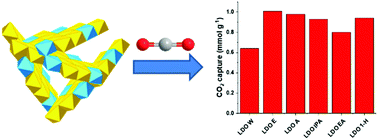Correlations of acidity-basicity of solvent treated layered double hydroxides/oxides and their CO2 capture performance†
Abstract
The basicity and acidity of solvent-treated layered double hydroxide (ST-LDHs) and their layered double oxides (ST-LDOs) have been fully studied using Hammett titration, in situ FTIR, CO2-TPD and NH3-TPD. Five solvents (ethanol, acetone, isopropanol, ethyl acetate and 1-hexanol) were selected to treat [Mg0.72Al0.28(OH)2](CO3)0.14 (Mg2.5Al-CO3 LDH) and compared with traditional LDH co-precipitated from water. The Brønsted basicity strength of the ST-LDHs and ST-LDOs increased but was accompanied by a decrease in basic site density. In addition, the Lewis acidity of ST-LDOs also changes significantly, with medium strength Lewis acid sites dissapearing after solvent treatment. We found that the CO2 capture capacity of solvent treated LDOs is 50% higher than that of traditional co-precipitated LDO sample. The ethanol treated LDO exhibited the highest CO2 uptake of 1.01 mmol g−1. The observed CO2 capture performance of the ST-LDOs correlates linearly with the ratio of total acid sites to total basic sites.



 Please wait while we load your content...
Please wait while we load your content...